Today we have our initial benchmarks of the Intel Xeon Bronze 3014 CPU. Instead of doing an expansive comparison, we are going to instead focus on two comparison CPUs: the Intel Xeon E5-2603 V3 and Intel Xeon E5-2603 V4. These CPUs each have the distinctive title of being the lowest cost CPU in each generation. They are commonly ordered with only one CPU in a system and are used for low-end storage and network service machines where CPU speed is simply not needed.
Intel de-tunes these chips for the market with lower QPI/ UPI speeds, lower maximum memory speeds than higher-end SKUs. They also do not feature Hyper-Threading which is a significant performance hit in most workloads today. At the same time, we have the exact same core count chips with only a 100MHz delta from V3 to V4 so this provides an intriguing comparison point for the last three generations.
Key stats for the Intel Xeon Bronze 3104: 6 cores / 6 threads, 1.7GHz and 8.25MB L3 cache. The CPU features 85W TDP. That means that the Bronze 3104 is not built for the 2017 single socket performance crown at just over $200 per CPU. This is a price point Intel has maintained for years. Here is the ARK comparison of all three CPUs for those who are looking for a generational comparison.
Test Configuration
Here is our basic test configuration for single socket Xeon Scalable systems:
- Motherboard: Supermicro X11SPH-nCTF
- CPU: Intel Xeon Bronze 3104
- RAM: 6x 16GB DDR4-2133 RDIMMs (Samsung)
- SSD: Intel DC S3710 400GB
- SATADOM: Supermicro 32GB SATADOM
One of the key advantages the Intel Xeon Bronze series has is the ability to use up to 12 DIMMs per socket. Intel’s embedded platforms cannot do this in 2017. DDR4-2133 is the fastest memory supported on the Xeon Bronze platform which is why we are not using faster speeds.
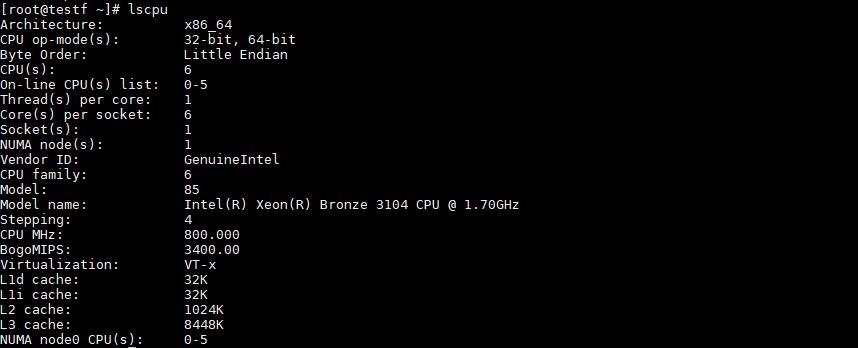
Memory bandwidth is up sharply in the newest generation of parts. While the E5-2603 V3/ V4 were limited to DDR4-1600/ DDR4 1866 operation, the Intel Xeon Bronze 3104 can handle 2133. Aside from the raw clock speed improvement, the new Xeon Bronze can use six memory channels per CPU. Between the clock speed and additional memory channels, the new Intel Xeon Bronze 3104 has about twice the memory bandwidth of the Intel Xeon E5-2603 V3.
Single Intel Xeon Bronze 3104 Benchmarks
For this exercise, we are using our legacy Linux-Bench scripts which help us see cross platform “least common denominator” results. We do have a full set of expanded benchmarks from our next-gen test suite (Linux-Bench2) so expect to see those results sprinkled in as we get a larger comparison data set built. These results have also been previewed elsewhere, such as the Intel Atom C3955 benchmarks we did so you can see larger data sets in our other reviews. Here we are going to focus on generational performance.
Python Linux 4.4.2 Kernel Compile Benchmark
This is one of the most requested benchmarks for STH over the past few years. The task was simple, we have a standard configuration file, the Linux 4.4.2 kernel from kernel.org, and make the standard auto-generated configuration utilizing every thread in the system. We are expressing results in terms of compiles per hour to make the results easier to read.
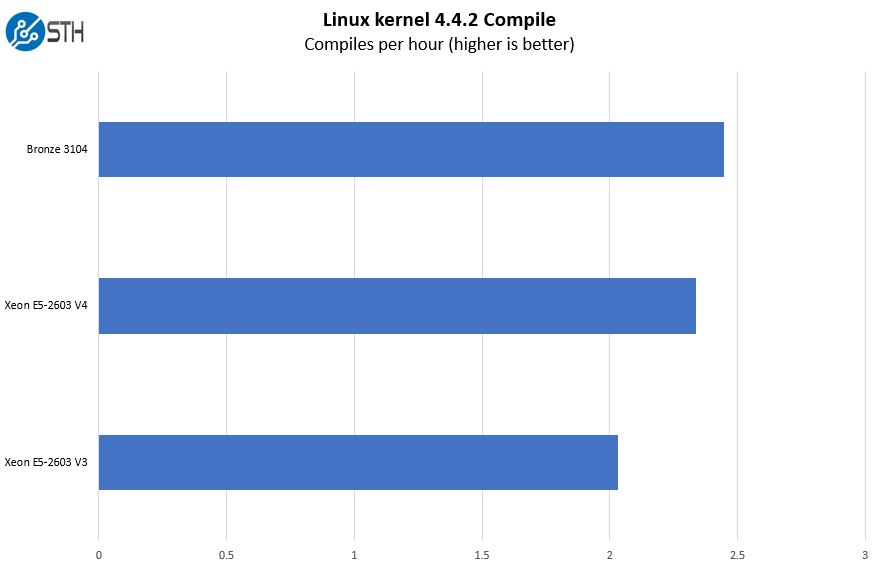
Here we see the impact of the “big” 100MHz clock speed jump more than anything. The Intel Xeon E5-2603 V3 to E5-2604 V4 was a 100MHz improvement (6.25%) which helped it increase performance a lot.
c-ray 1.1 Performance
We have been using c-ray for our performance testing for years now. It is a ray tracing benchmark that is extremely popular to show differences in processors under multi-threaded workloads.
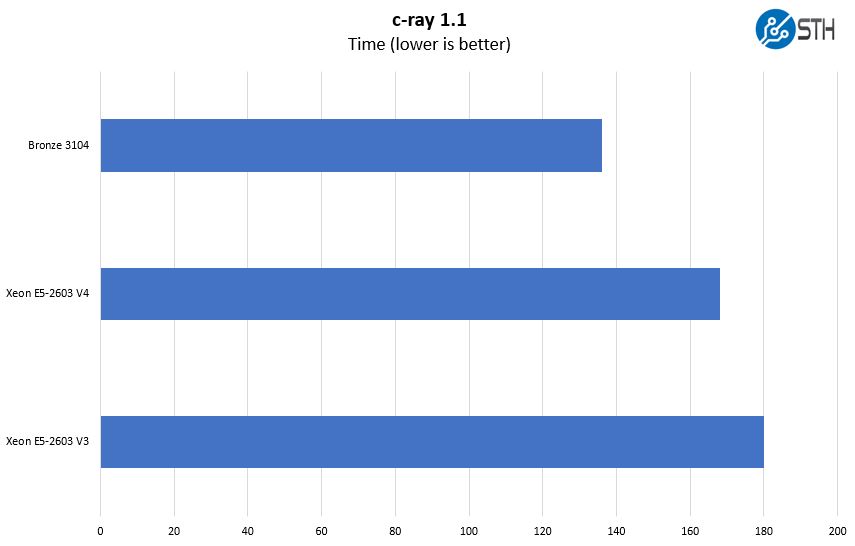
Here we actually see some major Intel Xeon Bronze 3104 performance gains.
7-zip Compression Performance
7-zip is a widely used compression/ decompression program that works cross platform. We started using the program during our early days with Windows testing. It is now part of Linux-Bench.
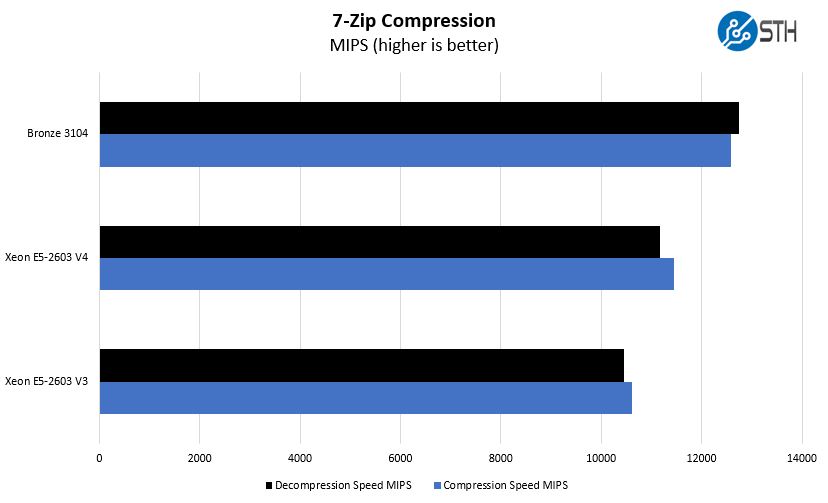
Here we have a nice bump from the Skylake-SP architecture. Remember that the E5-2603 V4 and Xeon Bronze 3104 are both 6 core 1.7GHz chips.
NAMD Performance
NAMD is a molecular modeling benchmark developed by the Theoretical and Computational Biophysics Group in the Beckman Institute for Advanced Science and Technology at the University of Illinois at Urbana-Champaign. More information on the benchmark can be found here. We are going to augment this with GROMACS in the next-generation Linux-Bench in the near future. With GROMACS we have been working hard to support Intel’s Skylake AVX-512 and AVX2 supporting AMD Zen architecture. Here are the comparison results for the legacy data set:
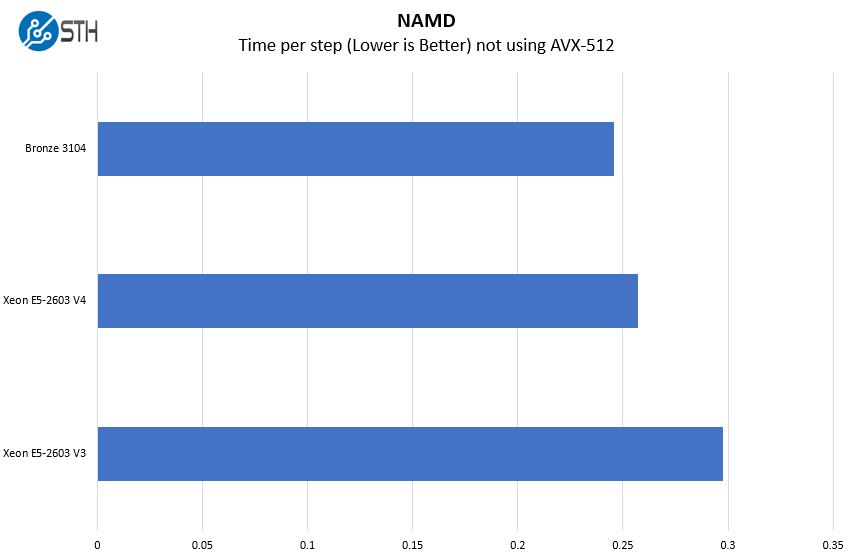
Here the clock speed is more prominent. There is a much larger improvement when we move to our AVX-512 GROMACS testing. Again, this is the wrong CPU to use for this type of workloads since these CPUs are decidedly used for their ability to provide PCIe lanes and memory channels rather than their compute performance.
Sysbench CPU test
Sysbench is another one of those widely used Linux benchmarks. We specifically are using the CPU test, not the OLTP test that we use for some storage testing.
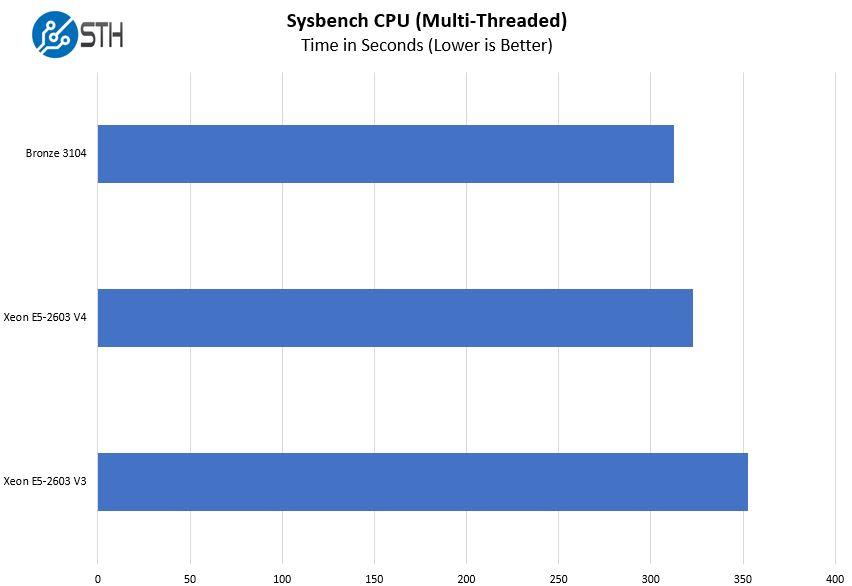
Here we see a nice performance gain over the three generations.
OpenSSL Performance
OpenSSL is widely used to secure communications between servers. This is an important protocol in many server stacks. We first look at our sign tests:
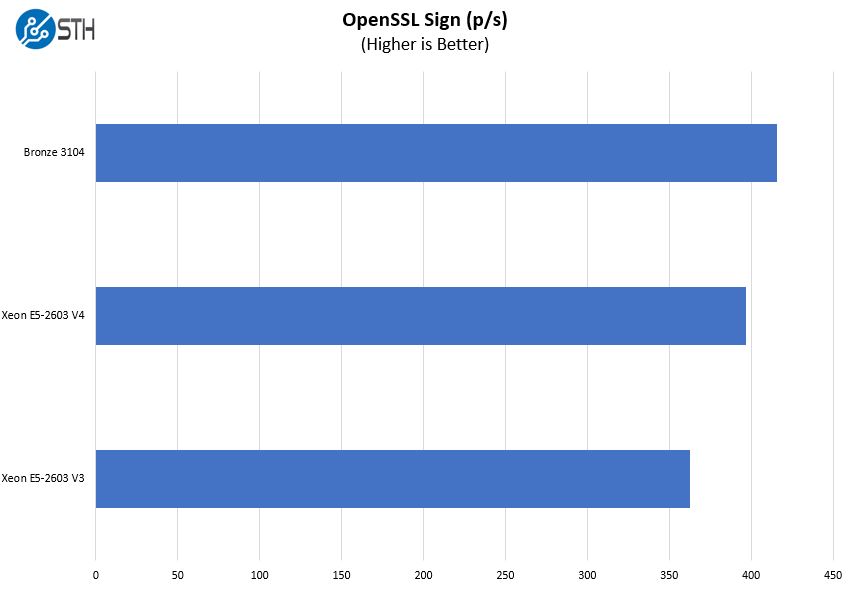
And the verify results:
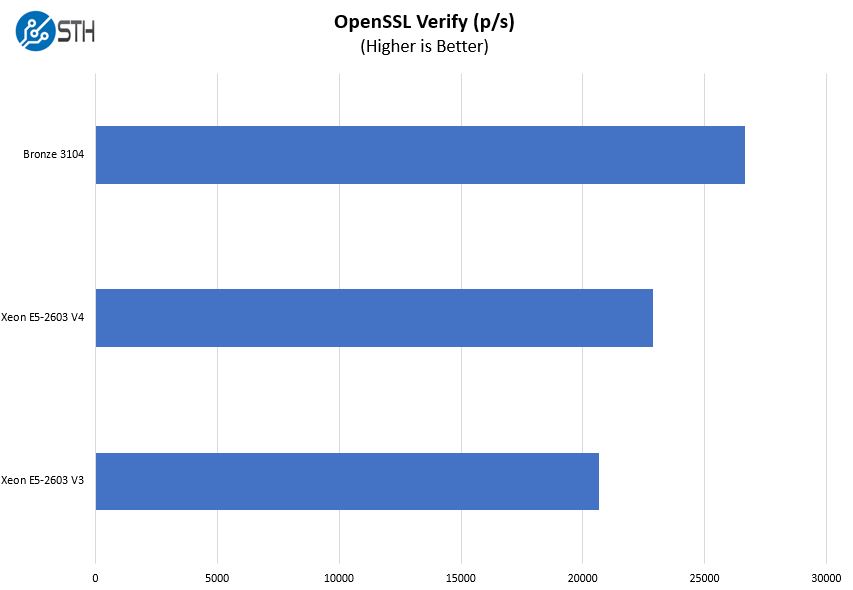
As you can see, we are getting some incremental performance gains with each generation.
UnixBench Dhrystone 2 and Whetstone Benchmarks
One longest-running tests is the venerable UnixBench 5.1.3 Dhrystone 2 and Whetstone results. They are certainly aging, however, we constantly get requests for them, and many angry notes when we leave them out. UnixBench is widely used so we are including it in this data set. Here are the Dhrystone 2 results:
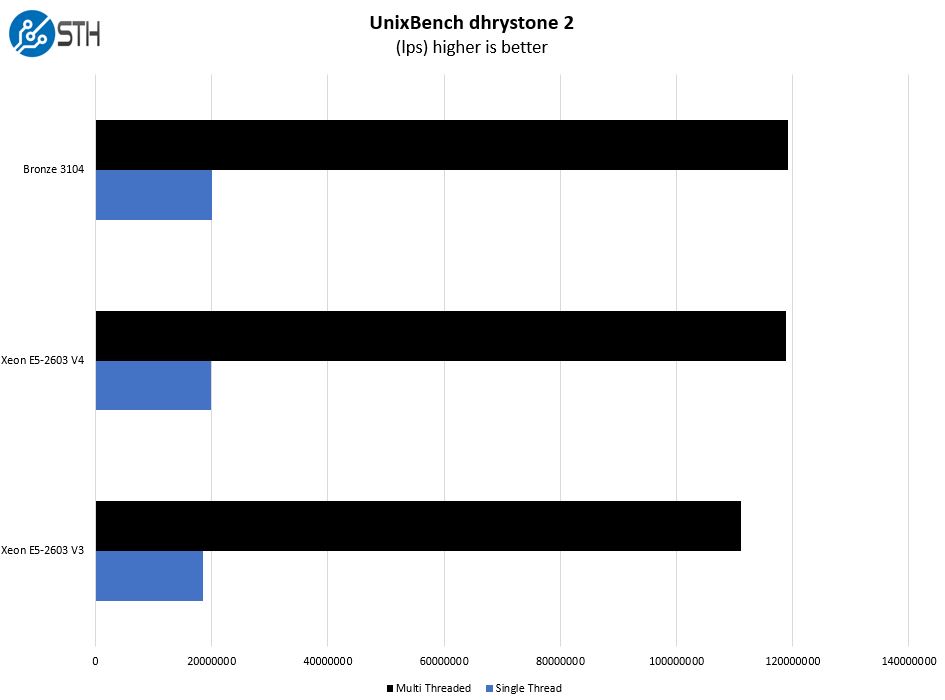
And the whetstone figures:
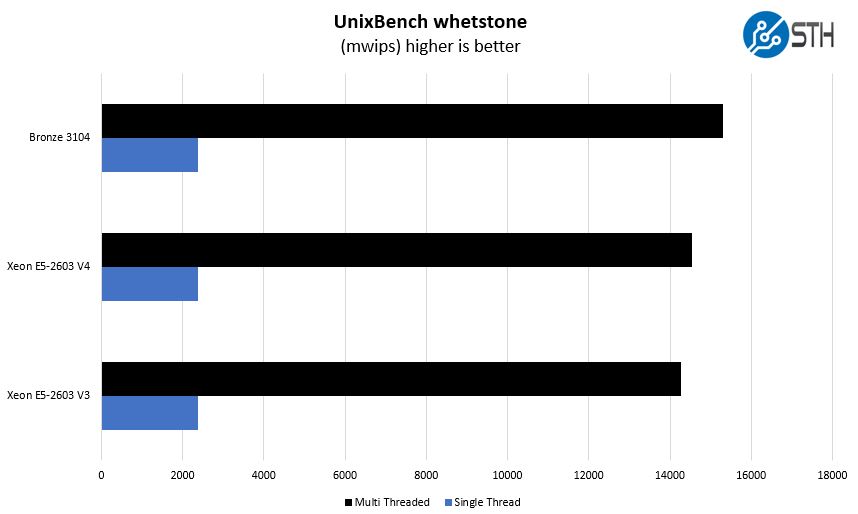
Again, we get a nice trend line.
Final Words
The Intel Xeon Bronze series is decidedly not the most exciting from a raw compute perspective. On the other hand, the Intel Xeon Bronze 3104 has more PCIe lanes, more and faster memory channels and can take advantage of the new Intel Xeon Scalable platform all for around $210. If all you need is a basic x86 CPU, this is certainly an option.
We did want to talk about power consumption briefly. Our test platform for the E5 systems and the Bronze were markedly different in terms of add-on devices so we are not going to publish head-to-head power numbers. On the other hand, TDP is not power consumption. The entire Intel Xeon Bronze 3104 system used a maximum of 85W at the wall running a heavy AVX-512 workload. Given the SSDs, onboard SAS3 controller, PCH, 10Gbase-T PHY, fans, power supply loss, and six DIMMs all in the platform, we can conclude that the CPU is using significantly less than that. We would also state that this is at least 10% less than what we would expect to see on a similarly configured Intel Xeon E5-2603 V4 system.
We hope this helps our readers understand how much performance has improved on the absolute lowest end dual socket SKUs over the last three generations. Although these chips are not meant for performance, it is still important to know what they provide. For some of our users, especially those building storage platforms, we are using the Intel Xeon Bronze 3104 numbers in our charts of other configurations so you can compare between the Intel Xeon Bronze and other CPUs at this price point.

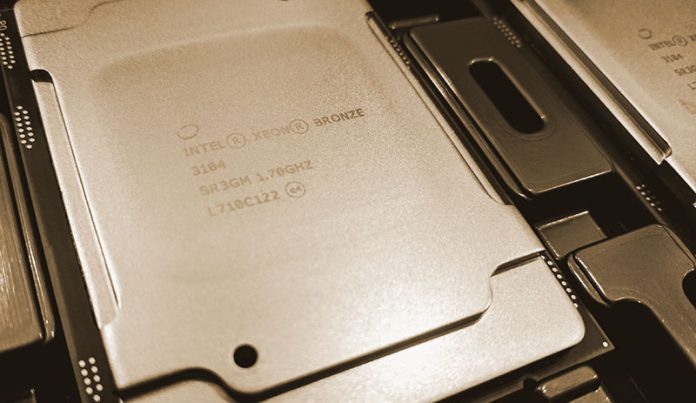



I know it’s a completely different segment, but any chance you have a comparison between the E3’s and the bronze? I’m looking to build a new NFS server, currently have an E3-1230v5, trying to see how performance of the new SP line is vs e3’s
thanks!
Bronze/Silver i meant to say.
Evan Richardson +1
I Would like that to
@Evan Richardson and @Brian Hansen – Intel Atom C3955 Benchmarks already has a bit of what you are looking for with the Atom C3000 series added in.
@Patrick Kennedy thanks. I missed that. I can gauge rough differences with the 1220v6…these #’s help. Thanks!
@Patrick Kennedy . It looks like only the first graph (kernel compile times) has the E3’s and sliver/bronze? the 7zip, cray, etc are only the denverton/other atoms?
Do these new processors also include the NSA backdoor?
http://blog.ptsecurity.com/2017/08/disabling-intel-me.html
https://web.archive.org/web/20121211162830/http://fm.csl.sri.com/LAW/2009/dobry-law09-HAP-Challenges.pdf